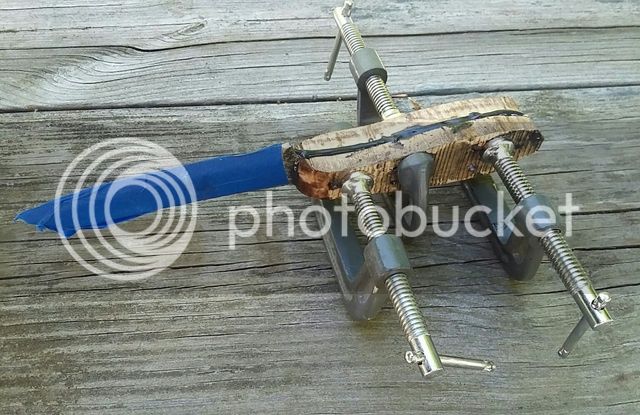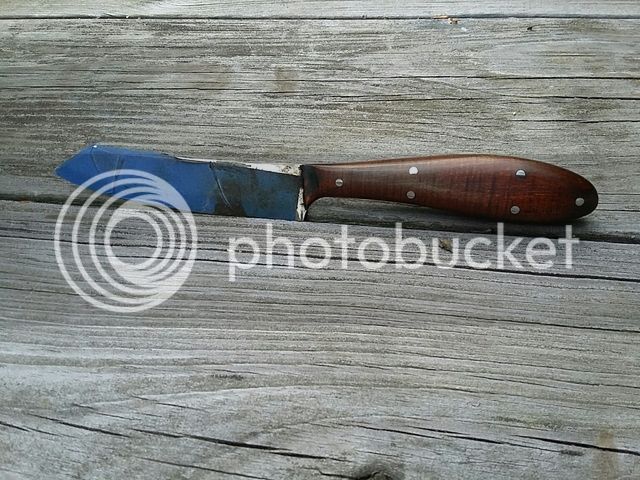You are using an out of date browser. It may not display this or other websites correctly.
You should upgrade or use an alternative browser.
You should upgrade or use an alternative browser.
Questions for the knife makers.
- Thread starter Bagman
- Start date

Help Support Muzzleloading Forum:
This site may earn a commission from merchant affiliate
links, including eBay, Amazon, and others.
Bagman, this is turning out just dandy!
Yeah, that's a nice looking knife. Now....I myself have made blades from files, saws, machetes, industrial hacksaws, etc. so I understand the interest in just fooling around but it probably ought to be kept at that level. I'd never do it with the idea of saving money.
On what the blacksmiths had...a variety of steels. Now I don't know but I also don't want to assume. There was Swedish iron and I think that was used to make blister and shear steel and then later on cast steel. Whether there were a variety of steels with other metals, nickel, etc.- that I don't know. I was under the assumption that getting carbon into the iron was the focus at tha time and not much else.
On what the blacksmiths had...a variety of steels. Now I don't know but I also don't want to assume. There was Swedish iron and I think that was used to make blister and shear steel and then later on cast steel. Whether there were a variety of steels with other metals, nickel, etc.- that I don't know. I was under the assumption that getting carbon into the iron was the focus at tha time and not much else.
- Joined
- May 6, 2014
- Messages
- 17,476
- Reaction score
- 16,559
I have been doing a lot of study on the use of Steels in the 18th and early 19th century both from my interest in period gunsmithing and period hand tools.
In the 18th century and up to the AWI, there was no significant quantities of Steel made in the Colonies. Raw Pig Iron, definitely, and some Hand Wrought Iron and Cast Iron, yes: but not Steel ”“ until the AWI demanded it.
I particularly looked into the Steels mentioned for use in Clock Springs and Gun Springs. It seems the best kinds available were known as “Norwegian/Norway Steel and Swiss Steel.” I even found out that British Gunmakers imported much or most of their Steel to make Springs. Some of that steel was also used for high quality knife blades and frame saw blades. High quality furniture makers used this steel for high quality dovetail, cross cut and ripsaw hand sews ”“ the latter two types in the style linked below. http://www.history.org/almanack/life/tools/images/handsaw.jpg
Some of the second quality steel was used to make Steel Rammers, and Coach Springs, though I have not run across a common name for that/those steel/s. I do not know for sure, but I think common/trade knife blades were commonly made from this/these second quality steel/s, though some cheap knives had only a core of steel for the edge that was sandwiched by a covering of Iron.
Plane Irons, Froes, Large and Small Chisels, Cleavers and Choppers were also made by sandwiching steel for the edge into an Iron body wrap. These items would have been frightfully expensive if made completely out of steel, as thick of blade as most of them normally were. I think large Pit Saws and Lumber Saws were made that way, most commonly, as well.
Prior to the AWI, files were extremely expensive because they had to be made from steel and because the teeth were hand cut. The Davistown Tool Museum has examples of worn out rasps and files provided steel for and having been refashioned into axes, hatchets, froes, hoof knives, draw knives, spoke shaves, turn screws, tin snips, currier’s knives, spuds, block knives, punches, food choppers, chisels, wedges, wrenches, tapered reamers, wrenches, cooper’s tools, etc. Some files were probably made into knives, but trade knives were cheaper than making knives from files, so the steel from rasps and files were most likely much more commonly used to make other needed items.
Gus
In the 18th century and up to the AWI, there was no significant quantities of Steel made in the Colonies. Raw Pig Iron, definitely, and some Hand Wrought Iron and Cast Iron, yes: but not Steel ”“ until the AWI demanded it.
I particularly looked into the Steels mentioned for use in Clock Springs and Gun Springs. It seems the best kinds available were known as “Norwegian/Norway Steel and Swiss Steel.” I even found out that British Gunmakers imported much or most of their Steel to make Springs. Some of that steel was also used for high quality knife blades and frame saw blades. High quality furniture makers used this steel for high quality dovetail, cross cut and ripsaw hand sews ”“ the latter two types in the style linked below. http://www.history.org/almanack/life/tools/images/handsaw.jpg
Some of the second quality steel was used to make Steel Rammers, and Coach Springs, though I have not run across a common name for that/those steel/s. I do not know for sure, but I think common/trade knife blades were commonly made from this/these second quality steel/s, though some cheap knives had only a core of steel for the edge that was sandwiched by a covering of Iron.
Plane Irons, Froes, Large and Small Chisels, Cleavers and Choppers were also made by sandwiching steel for the edge into an Iron body wrap. These items would have been frightfully expensive if made completely out of steel, as thick of blade as most of them normally were. I think large Pit Saws and Lumber Saws were made that way, most commonly, as well.
Prior to the AWI, files were extremely expensive because they had to be made from steel and because the teeth were hand cut. The Davistown Tool Museum has examples of worn out rasps and files provided steel for and having been refashioned into axes, hatchets, froes, hoof knives, draw knives, spoke shaves, turn screws, tin snips, currier’s knives, spuds, block knives, punches, food choppers, chisels, wedges, wrenches, tapered reamers, wrenches, cooper’s tools, etc. Some files were probably made into knives, but trade knives were cheaper than making knives from files, so the steel from rasps and files were most likely much more commonly used to make other needed items.
Gus
Last edited by a moderator:
I wish Chuck was still around, he had all the data on this topic. First, I agree, virtually all steel in the earliest days was brought in from Sheffield. The iron was originally produced in Sheffield but for some reason they started using that from Scandinavia. I think blister steel was sort of a glorified case hardening in which the carbon seeped deeper into the iron. There were long "pots" that bars of iron were placed and then a carbon source- bone meal, etc. then another iron bar. When these pots were full they were sealed and cooked in a furnace for many days.
The next was shear steel and double shear steel. I think this was a laminate of blister steel sort of a Damascus type product. Then cast steel got going, I think the outside of blister steel was filed away and these carbon enriched filings were melted and cast- now the carbon was evenly dispersed through the steel. Originally cast steel- as you said- was used for clock springs, etc. but then the cutlery trade started using it as well.
On the shipments- I saw some inventory for the North West Co. in which just steel stock or bars was shipped but I don't know if it was used for knives. I sort of doubt it as thousands of cheap knives were also on the list. The shipped steel bar was probably used to fix broken trap springs or other used around a post. But that's just a guess on my part.
American blacksmith made knives in the very early days? Maybe buggy springs, etc.- some blacksmith figured they could be re-worked into a knife blade.
The next was shear steel and double shear steel. I think this was a laminate of blister steel sort of a Damascus type product. Then cast steel got going, I think the outside of blister steel was filed away and these carbon enriched filings were melted and cast- now the carbon was evenly dispersed through the steel. Originally cast steel- as you said- was used for clock springs, etc. but then the cutlery trade started using it as well.
On the shipments- I saw some inventory for the North West Co. in which just steel stock or bars was shipped but I don't know if it was used for knives. I sort of doubt it as thousands of cheap knives were also on the list. The shipped steel bar was probably used to fix broken trap springs or other used around a post. But that's just a guess on my part.
American blacksmith made knives in the very early days? Maybe buggy springs, etc.- some blacksmith figured they could be re-worked into a knife blade.
Then cast steel got going, I think the outside of blister steel was filed away and these carbon enriched filings were melted and cast- now the carbon was evenly dispersed through the steel.
I dunno if that is right or wrong. :idunno: Don't care. But, my experience says it is good stuff. I do woodturning. Several years ago I bought some turning tools at a yard sale that are very old. Only identification on them says "cast steel". They are great tools and hold an edge forever. I paid $5.00 each. Compared to other tools I have at $80.00 to $100.00 each that dull almost instantly, they were a great bargain.
- Joined
- May 6, 2014
- Messages
- 17,476
- Reaction score
- 16,559
Yep, and if you find old tools with "Krupp Stahl" (Krupp Steel) stamped on them, they are almost certainly going to be good tools as well.
Gus
Gus
Similar threads
- Replies
- 0
- Views
- 360
- Replies
- 23
- Views
- 3K
- Replies
- 17
- Views
- 1K
- Locked
- Replies
- 5
- Views
- 1K





